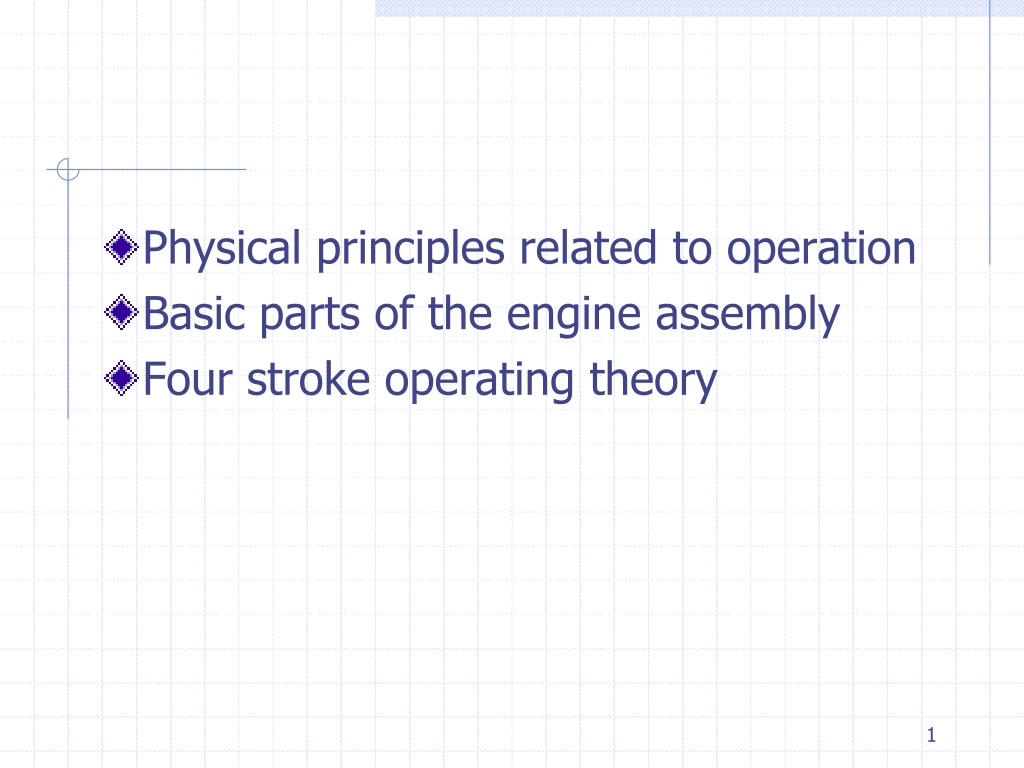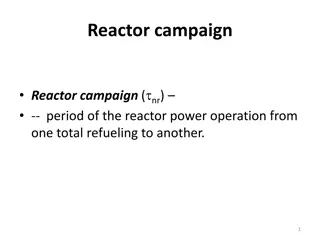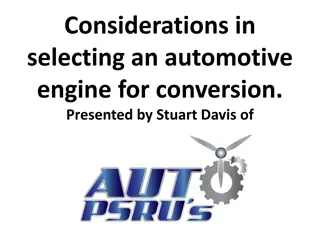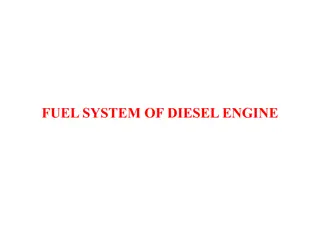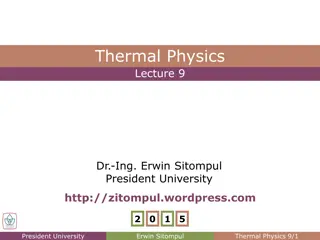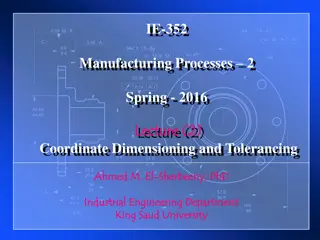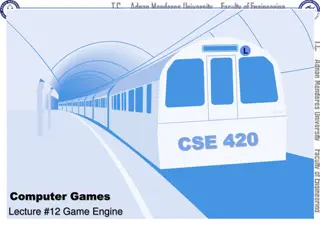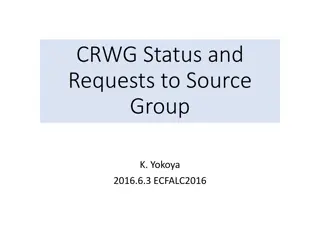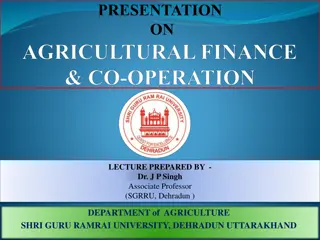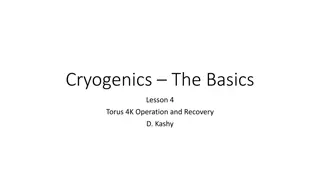Understanding Basic Engine Operation Principles
Explore the physical principles related to engine operation, energy conversion, and the basic parts of a gasoline engine assembly. Learn about atmospheric pressure, vacuum, temperature-pressure-volume relationship, states of matter, and how engines and motors convert energy. Dive into the components like the cylinder block, piston, piston rings, piston pin, connecting rod, crankshaft, cylinder head, intake/exhaust valves, camshaft, timing gears, and spark plug. Understand the roles of these components in converting heat energy to mechanical energy. Discover the functions of the cylinder block, piston, piston rings, piston pins, connecting rod, crankshaft, and the V vs. W crank configurations. Also, learn about the flywheel's role in maintaining inertia during power stroke intervals.
Download Presentation

Please find below an Image/Link to download the presentation.
The content on the website is provided AS IS for your information and personal use only. It may not be sold, licensed, or shared on other websites without obtaining consent from the author. Download presentation by click this link. If you encounter any issues during the download, it is possible that the publisher has removed the file from their server.
E N D
Presentation Transcript
Physical principles related to operation Basic parts of the engine assembly Four stroke operating theory 1
Physical Principles related to Engine Operation Energy conversion Atmospheric pressure Vacuum Pressure The relationship between temperature, pressure and volume. The three states of matter. 2
Energy Conversion Engines take heat energy and convert it into mechanical energy. Motors take electrical energy and convert it into mechanical energy. 3
Basic Parts of the Gasoline Engine Cylinder block Piston Piston rings Piston pin Connecting rod Crankshaft Cylinder head Intake valve Exhaust valve Camshaft Timing gears Spark plug 4
Cylinder Block Basic frame of gasoline engine. Contains the cylinder. 5
Piston A sliding plug that harnesses the force of the burning gases in the cylinder. 6
Piston Rings The rings seal the compression gases above the piston keep the oil below the piston rings. 7
Piston Pins Also known as the wrist pin, it connects the piston to the small end of the connecting rod. It transfers the force and allows the rod to swing back and forth. 8
Connecting Rod Connects the piston and piston pin to the crankshaft. 9
Crankshaft Along the the piston pin and connecting rod it converts the up and down motion (reciprocating) of the engine to spinning (rotary) motion. 10
Flywheel Carries the inertia when there is no power stroke. 12
Cylinder Head Forms the top of the combustion chamber. Contains the valves, the passageways for the fuel mixture to move in and out of the engine. 14
W Head 15
Intake and Exhaust Valves Doorway that lets the gases in and out of the engine. 16
Camshaft Through the use of an eccentric the cam lobes push the valves open. The valve springs close them. 17
Timing Gears These gears drive the camshaft from the crankshaft. 18
Spark Plug Electric match used to begin the combustion process of burning air and gasoline to create heat. 19
Engine Related Terms TDC (top dead center) BDC (bottom dead center) Stroke Bore Revolution Compression Ratio Displacement Cycle 20
Four Stroke Cycle Intake Compression Power Exhaust 21
Intake Stroke Intake valve opens. Piston moves down, turn of crankshaft. A vacuum is created in the cylinder. Atmospheric pressure pushes the air/fuel mixture into the cylinder. 22
Compression Stroke Valves close. Piston moves up, turn of crankshaft. Air/fuel mixture is compressed. Fuel starts to vaporize and heat begins to build. 23
Power Stroke Valves remain closed. Spark plug fires igniting fuel mixture. Piston moves down, turn of crankshaft. Heat is converted to mechanical energy. 24
Exhaust Stroke Exhaust valve opens. Piston move up, crankshaft makes turn. Exhaust gases are pushed out polluting the atmosphere. 25
Rotary Engine rotary-engine-intro 28
Diesel Animation diesel 29
Diesel 31
Why not diesel? 1. Diesel engines, because they have much higher compression ratios (20:1 for a typical diesel vs. 8:1 for a typical gasoline engine), tend to be heavier than an equivalent gasoline engine. 2. Diesel engines also tend to be more expensive. 32
Why not diesel? 3. Diesel engines, because of the weight and compression ratio, tend to have lower maximum RPM ranges than gasoline engines (see Question 381 for details). This makes diesel engines high torque rather than high horsepower, and that tends to make diesel cars slow in terms of acceleration. 4. Diesel engines must be fuel injected, and in the past fuel injection was expensive and less reliable Question 381 33
Why not diesel? 5. Diesel engines tend to produce more smoke and "smell funny". 6. Diesel engines are harder to start in cold weather, and if they contain glow plugs, diesel engines can require you to wait before starting the engine so the glow plugs can heat up. 7. Diesel engines are much noisier and tend to vibrate. 8. Diesel fuel is less readily available than gasoline 34
Why not diesel? One or two of these disadvantages would be OK, but a group of disadvantages this large is a big deterrent for lots of people. 35
Advantages The two things working in favor of diesel engines are better fuel economy and longer engine life. Both of these advantages mean that, over the life of the engine, you will tend to save money with a diesel. However, you also have to take the initial high cost of the engine into account. You have to own and operate a diesel engine for a fairly long time before the fuel economy overcomes the increased purchase price of the engine. The equation works great in a big diesel tractor- trailer rig that is running 400 miles every day, but it is not nearly so beneficial in a passenger car. 36
The Cycle How many revolutions of the crankshaft does it take to complete the four strokes? If an engine idles at 500 rpm, how many power strokes occur per minute? How many power strokes per second? How about at 5000 rpm or 10,000 rpm? 37
